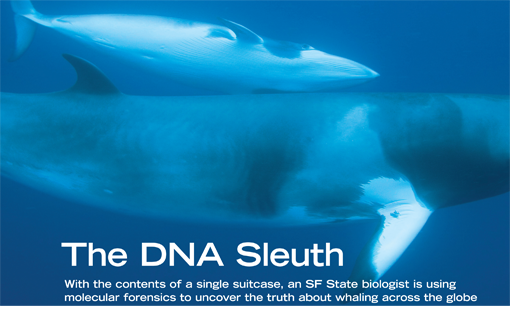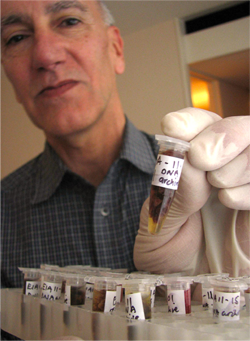by Matt Villano

Whaling Nations never know when Frank Cipriano will be paying them a visit, and that's by design. The associate professor of biology doesn't want anyone tampering with the evidence in his scientific detective work.
That science, known as molecular forensics, or more simply, "DNA identification," hinges on a mobile and portable DNA identification testing methodology that Cipriano developed in the 1990s with colleagues Scott Baker and Stephen R. Palumbi, when they worked together at the University of Hawaii. The process is derived from standard laboratory methods, but incorporates lab equipment and materials that fit into a suitcase, allowing the procedure to be accomplished in a hotel room anywhere in the world. What's more, because it generates artificial copies of the DNA, the approach does not require permits for transporting tissue samples across international boundaries.
Over the last decade, Cipriano has been using the technique in a number of countries to identify products containing a large number of endangered or threatened whale and dolphin species, even though only a few have been the target of "scientific whaling." The technique also has garnered international attention for its role in identifying falsely labeled and advertised whale products in Japan, which still engages in whaling through a loophole in the current whaling moratorium.
All of these Japanese surveys have been conducted in secret; Cipriano performs DNA analysis and identification in his hotel room and does not publicize his presence in the country or the results of the research until he returns to the U.S.
"We have locals purchase the products for us anonymously, and keep things under wraps to make sure we have an unbiased sample," he says. "It definitely is not about the drama."

The first survey in Japan was conducted by Scott Baker in 1993 and he and Cipriano started work in Korea in 1994. In 1999 -- the same year Cipriano came to SF State -- the first survey (sponsored by the U.K.-based Whale and Dolphin Conservation Society) coordinated DNA analysis with pollutant testing.
For the 1999 survey, undercover shoppers visited Japanese fish markets to procure 99 different samples of what was being sold as meat from large (baleen) whales. After testing, the data indicated that much of the flesh was from dolphins and porpoises, while other products billed as coming from the relatively common Minke whale were actually from illegally killed endangered species.
As if proving this high-stakes switcheroo wasn't damning enough, toxicologists in Japan were hired to run tests on a number of samples and determined that most of the mislabeled meat (and 100 percent of the products from "toothed whales" such as dolphins and porpoises) was highly contaminated.
"We discovered dolphin liver samples with up to 600 times the allowed level of mercury," he recalls. "Even if you cooked the stuff for hours, anyone who ate it would have been exposed to dangerous amounts of the metal."
See more of The DNA Sleuth.